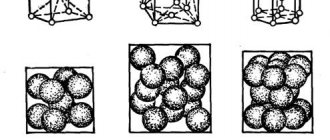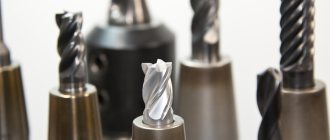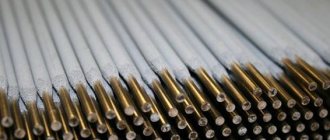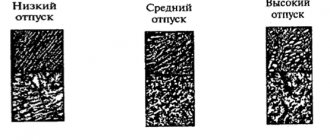What are the alloys?
At the moment, there are many alloys that are used in all industries.
Alloys are classified according to various criteria. By manufacturing method
- Cast ones are obtained by crystallization of mixed melts.
- Powdered ones are produced by pressing a mixture of powders followed by sintering.
By methods of obtaining
- Foundries (cast iron).
- Deformable (steel).
- Powder (alloys obtained from powders and ceramics).
Distribution of alloys in modern industry
It should be noted that all metals that are intensively used by modern industry are alloys. Thus, more than 90% of all iron produced in the world is used for the production of cast iron and various steels. This approach to the matter is explained by the fact that metal alloys in most cases demonstrate better properties than their “progenitors”.
Thus, the yield strength of pure aluminum is only 35 MPa. But if you add 1.6% copper, magnesium and zinc to it in a ratio of 2.5% and 5.6%, respectively, then this figure can easily exceed even 500 MPa. Among other things, electrical conductivity, thermal conductivity, or other properties can be significantly improved. There is no mysticism in this: in alloys, the structure of the crystal lattice changes, which allows them to acquire other properties.
Simply put, the amount of this kind of material is large these days, but it is constantly growing.
Alloy characteristics
All alloys are characterized by shine, conductivity of heat and electric current, ductility, etc. The structure of metals determines various properties:
- the nature and quantity of metals and non-metals in alloys (density, melting and evaporation points, etc.);
- individual properties of metals.
The characteristics of alloys are classified into chemical and mechanical. Chemical ones reflect the relationship to water, air and other active media, and mechanical ones - to external forces.
Classification
Metallurgists classify metal alloys according to several criteria:
- manufacturing method:
- cast;
- powder;
- production technology:
- foundries;
- deformable;
- powder;
- homogeneity of structure:
- homogeneous;
heterogeneous;
- type of metal - basics:
- black (iron);
- non-ferrous (non-ferrous metals);
- rare metals (radioactive elements);
- number of components:
- double;
- triple;
- and so on;
- physicochemical characteristics:
- refractory;
- fusible;
- high strength;
- heat resistant;
- hard;
- antifriction;
- corrosion-resistant, etc.;
- purpose:
- structural;
- instrumental;
- special.
Types of alloys based on them
Metals and alloys based on them have different physical and chemical characteristics.
The metal having the largest mass fraction is called the base.
Types of metal alloys
In nature, metals do not exist in their pure form. Various types of alloys are used in production.
- Steel . Steel is a homogeneous iron-based mixture that contains up to 2.14% carbon. Industrial installations, equipment, tools, etc. are made from it. It is characterized by special strength and elasticity.
- Cast iron. Cast iron is an iron-based alloy (carbon content up to 3.5%). It is a brittle material compared to steel. It is used in areas where huge loads need to be carried.
- Ferrites. Ferrites are alloys with a high carbon content. They are used in the manufacture of transformers, inductors and other products.
- Brass. Brass is a copper-based mixture that contains up to 48-50% zinc. It does not corrode. It is used in mechanical engineering.
- Zinc alloys. Zinc alloys have a low melting point and are resistant to corrosion. Zinc alloys are used in the production of machinery, computer equipment and other fields. They have anti-friction properties.
- Titanium alloys. Titanium is a rather rare element in nature. Titanium alloys have high strength, low specific gravity and resistance to various destructive environments and heating.
- Aluminum alloys. Aluminum alloys are used in many industries due to the material's durability, resistance to subzero temperatures, and availability. But they have one drawback - low heat resistance. Aluminum alloys are used in the production of weapons, as well as in the manufacture of electrical equipment and electronics. High conductivity and low magnetization make it possible to make phones, computers, tablets, smartphones and other equipment from them.
- Copper alloys. Various grades of brass are called copper alloys. If the mixture contains 8-10% zinc, then brass is considered red, and if it is 30-40%, then it is yellow. Brass is easy to machine and is often used to make small parts with great precision. The gears in the famous Swiss watches are made of brass. Various decorative items are also made from brass. Silicon is sometimes added to the alloy. The resulting material is called silicon bronze. It has great strength. The Spartans made swords from it. Diaphragms and leaf springs are made of copper alloys in which silicon replaces phosphorus.
- Hard alloys. Hard alloys practically do not wear out during operation. They retain their properties at temperatures of 1100˚C. Cutting tools, measuring and mining equipment, parts and assemblies of nuclear and chemical reactors and other products are made from hard alloys.
Physical properties
The physical properties of an alloy depend on its composition and can vary significantly. Unlike brass, bronze has higher anti-corrosion resistance and anti-friction properties. It is more durable and has strong resistance to air, water, salt, and organic acids. Bronze is also easy to solder and weld .
- Density: 7800-8700 kg/m3.
- Melting point: 930С – 1140С.
- Color ranges from red to white.
- It has increased wear resistance and a low friction coefficient, copes even at low temperatures down to -250С.
- Some types of bronze have high vapor resistance, thermal conductivity and electrical conductivity and are used in equipment operating in harsh conditions.
Metal intensity
Many metals are subject to corrosion, that is, spontaneous destruction as a result of external influences. Enterprises may suffer losses due to corrosion. This is due not only to the high aggressiveness of technological environments and the harsh operating conditions of the equipment, but also to the high metal consumption of the equipment. Metal intensity is the amount of metal that is consumed to create a metal product.
Thus, alloys are used in almost all industries. Homogeneous mixtures of metals have high strength and reliability. They are classified according to various criteria, which makes it possible to increase the efficiency of using alloys. The list of metal alloys is updated every year.
Basic definitions
In general, metal alloys are materials obtained by smelting, in the production of which two or more metal elements (in the chemical sense) were used, as well as (optionally) special additives.
One of the first materials of this kind was bronze. It is composed of 85% copper and 15% tin (80:20 in the case of bell bronze). Currently, there are several varieties of this compound that do not contain tin at all. But they don't occur very often. It is necessary to clearly understand that metal alloys in most cases are formed without any human involvement at all. The fact is that it is possible to obtain a material that is absolutely pure from a chemical point of view only in the laboratory. Any metal that is used in everyday life probably contains traces of another element. A classic example is gold jewelry. Each of them contains a certain proportion of copper. However, in the classical sense, this definition still means a compound of two or more metals, which was purposefully obtained by man.
The entire history of man is an excellent example of how metal alloys were able to have a huge impact on the development of our entire civilization. It is no coincidence that there is even a long historical period called the “Bronze Age”.
Aluminum alloys
As we have already said, it is absolutely impossible to imagine modern industry without them. Judge for yourself: aluminum alloys are actively used in aviation, space, military, scientific and engineering and other industries. Without aluminum, it is impossible to imagine manufacturers of modern household and mobile appliances, since cases made of this metal are increasingly used by modern flagships of these industries.
Become
All iron compounds containing up to 2% carbon are called steels.
If the composition contains chromium, vanadium or molybdenum, then they are called alloyed. We encounter these materials constantly, daily and hourly. The number of steels today is such that listing them alone could fill a not-too-thin book. We have already said that the mechanical properties of metals and alloys are very different, but in the case of these materials, even different types of steel often have opposite qualities, which is why their areas of application differ greatly.
If the material contains less than 0.25% carbon, then it is used in some technical structures. If the steel contains more than 0.55% carbon, it is ideal for the production of a variety of high-quality cutting tools, including lathe cutters, drills and surgical supplies. But if we are talking about devices that are used for fast cutting, then only alloy steel is used for their production.
Lead alloys
In general, non-ferrous metals and alloys are inseparably related concepts, since since ancient times people have been able to smelt multi-component materials, which they successfully used in military and peaceful affairs.
This especially applies to lead, from whose alloys the Romans made water pipes and sewerage systems. Of course, they did not know about the toxic properties of this metal, but they were impressed by the ease of its processing. The most commonly known solder at present is conventional solder, which is made from one part lead and two parts tin. As the name suggests, it is used for soldering parts. Used in radio engineering and other technical industries. Antimony and lead are used to make alloys that are used to make sheaths for various types of cables.
It has long been known that compounds of this metal with cadmium, bismuth or tin can melt at approximately 70 degrees Celsius. That is why today they are used to make various fuses in automatic fire extinguishing systems.
Oddly enough, lead has long been known to chefs and restaurateurs, as tableware and cutlery were often made from it. The alloy used for this is called pewter. It contains approximately 85–90% tin. The remaining 10-15% is occupied by lead (a standard alloy of two metals).
Technicians are also likely familiar with babbitts. These are also lead-based compounds that also contain tin, as well as arsenic and antimony. These alloys are very poisonous, but due to some special properties they are actively used in the bearing industry.
Cast iron
If an iron alloy contains more than 3-4% carbon, then it is called cast iron. In addition, its important element is silicon. A lot of parts and finished products are made from cast iron. For example, engine blocks for cars. In the case of a high-quality casting without cavities or cavities, the product has impressive mechanical strength. In this regard, it is worth recalling at least the guns of the 14th-15th centuries, which often withstood a three to fourfold increase in the powder charge.
Of course, the use of metals and alloys was never limited exclusively to the military industry, but it often turned out that it was this branch of industry that constantly found new methods of metal processing, moving forward the entire civilization.
Magnesium alloys
They have extremely low weight and are also characterized by very impressive strength. In addition, these materials are excellent for the foundry industry, and the workpieces are perfectly amenable to turning and milling. Therefore, they are actively used in the production of missiles and aircraft turbines, instrument housings, car wheel rims, as well as some types of armor steel.
Some varieties of these alloys are distinguished by excellent viscous damping properties, and therefore they are used for the production of parts and structures that have to work under conditions of extremely high levels of vibration.










